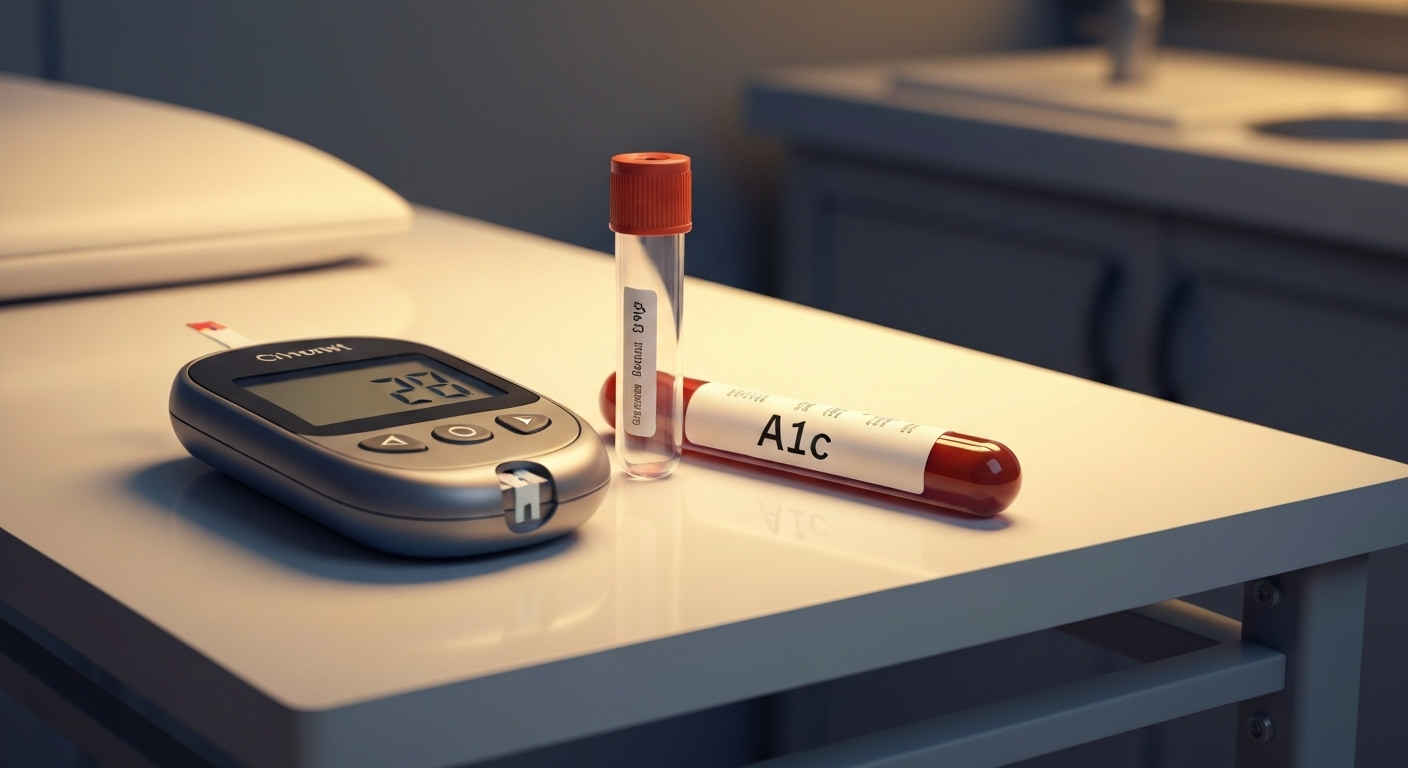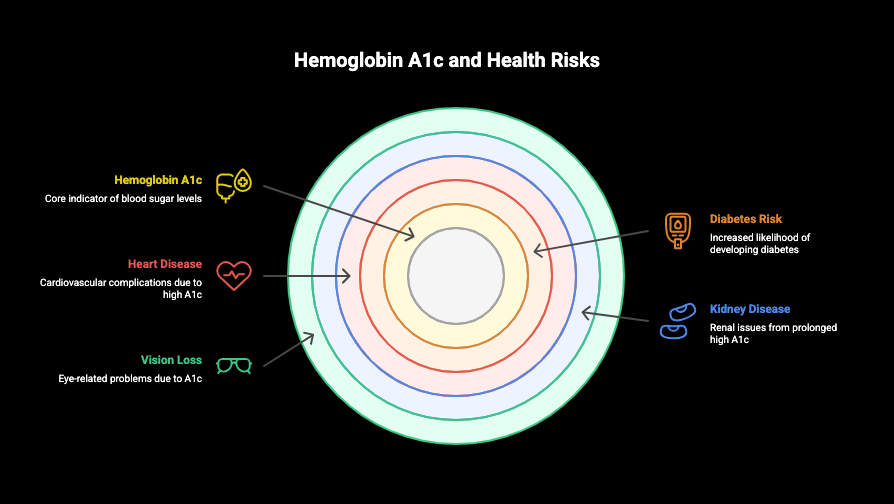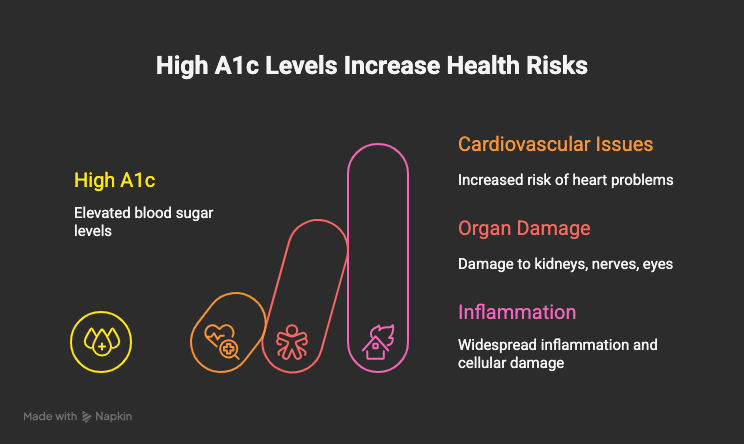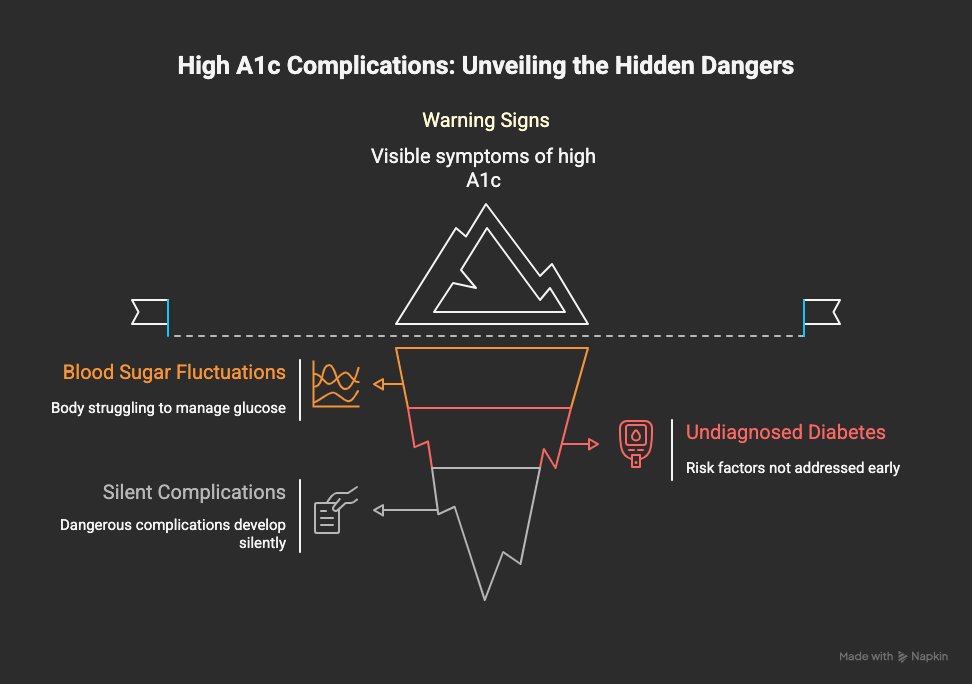
Key Highlights
- A high hemoglobin A1c level indicates that your average blood sugar has been elevated over the past few months.
- This measurement is a key indicator of your diabetes risk factors and overall metabolic health.
- Persistently high A1c levels significantly increase your risk of serious diabetes complications.
- Major health dangers include a higher likelihood of developing heart disease, kidney disease, vision loss, and nerve damage.
- Even A1c levels in the prediabetes range can signal underlying metabolic issues that require attention.
- Understanding and managing your A1c is crucial for preventing long-term damage to your body.

Introduction
Have you ever wondered what your hemoglobin A1c number really means for your health? This simple blood test offers a powerful look into your body’s ability to manage blood glucose levels over a two-to-three-month period. It’s more than just a metric for your diabetes status; it’s a critical indicator of your overall health. Understanding the hidden dangers of a high A1c is the first step toward preventing serious medical conditions and taking control of your long-term well-being.
Standard A1c Ranges and Their Meanings
To understand your A1c test results, it helps to know the standard ranges. According to the American Diabetes Association, these ranges are used to classify your metabolic health status and guide a potential diabetes diagnosis. Falling into the prediabetes or diabetes A1c range means you need to take action.
A level below 5.7% is considered the normal range. An A1c between 5.7% and 6.4% indicates prediabetes, a warning sign that you are at high risk of developing type 2 diabetes. A diagnosis of diabetes is typically made with an A1c of 6.5% or higher.
|
A1C Level |
Meaning |
|---|---|
|
Below 5.7% |
Normal |
|
5.7% to 6.4% |
Prediabetes |
|
6.5% or higher |
Diabetes |
For most adults already living with diabetes, the recommended target range is generally below 7%. However, an A1c of 9% or higher is considered dangerously high, as it dramatically increases the risk of severe complications.
Thresholds for Health Risks and Complications
The health risks associated with a high A1c begin to climb even before a formal diabetes diagnosis. Research from the New England Journal of Medicine shows that complication risk starts to rise with A1c levels above 5.5%, accelerating significantly once you cross the 6.5% threshold. This increased risk is not just for people with diabetes; even those in the prediabetic range face a greater chance of developing cardiovascular issues.
Chronic blood sugar fluctuations are the root cause of the problem. When your blood sugar levels are consistently high, your body experiences widespread inflammation and cellular damage. This creates a higher risk for a variety of health issues that can develop over time if the A1c level remains elevated.
What complications can develop if A1c remains high over time? The list is extensive and includes damage to your heart, kidneys, nerves, and eyes. Every percentage point increase in your A1c corresponds to a greater likelihood of these long-term problems, making early detection and management essential.

Mechanisms Linking High A1c to Cardiovascular Problems
The connection between high A1c and heart issues is rooted in several damaging mechanisms. The underlying high blood sugar acts as a primary cardiovascular risk factor by directly harming the blood vessels. This damage makes arteries stiffer and more prone to plaque buildup, which restricts blood flow to the heart.
Furthermore, high glucose levels are closely linked to insulin resistance, a condition where your body’s cells don’t respond properly to insulin. This state promotes inflammation and can lead to high blood pressure and unhealthy cholesterol levels, further straining your heart.
Over time, these factors can weaken the heart muscle, increase the risk of blood clots, and contribute to serious events like heart attacks, strokes, and even heart failure. This is why managing your A1c is not just about blood sugar control—it’s about protecting your heart.
Warning Signs and Symptoms to Watch For
While many of the most dangerous complications of high A1c develop silently, there are some warning signs that can indicate your blood sugar levels are too high. Paying attention to these symptoms is important, but you should never wait for them to appear before getting your A1c checked, especially if you have risk factors for diabetes.
If you experience any of the following, it’s a good idea to speak with a healthcare provider:
- Intense or frequent thirst
- Increased urination, especially at night
- Unexplained fatigue or tiredness
- Blurry vision
These symptoms are often caused by blood sugar fluctuations and can be a sign that your body is struggling to manage glucose. Addressing these warning signs early can help you get the diagnosis and treatment you need to prevent more serious health problems from developing.

Nerve Damage and Neuropathy
Another one of the most common diabetes complications is nerve damage, or neuropathy. High blood sugar damages the small blood vessels that supply oxygen and nutrients to your nerves, particularly those in your feet and hands. This can lead to symptoms like tingling, numbness, burning, or sharp pains.
This damage isn’t limited to your limbs. High A1c can also affect the autonomic nervous system, which controls involuntary functions like digestion, heart rate, and blood pressure. This can cause problems ranging from digestive issues to dangerous drops in blood pressure.
Good blood sugar control is the best way to prevent or slow the progression of neuropathy. Lifestyle choices like a healthy diet and regular physical activity can make a significant difference in protecting your nerves from the damaging effects of high glucose.
Frequently Overlooked Risks of Elevated A1c
While heart, kidney, and nerve problems are well-known consequences of a high A1c, other serious health risks are often overlooked. The pervasive damage caused by high hemoglobin A1c can impact systems you might not expect, including your eyes and even your brain.
Without vigilant disease control, these hidden dangers can silently progress until significant damage has occurred. It’s crucial to be aware that a high A1c is linked to an increased risk of diabetic retinopathy and cognitive decline, further underscoring the need for proactive management.
Eye Health and Vision Loss
Did you know that diabetic retinopathy is a leading cause of blindness in working-age adults? This condition is directly linked to high A1c levels. Chronic high blood sugar damages the tiny, delicate blood vessels in the retina, the part of your eye that senses light. Initially, these vessels may leak fluid, causing blurred vision.
As the condition progresses, new, abnormal blood vessels can grow, which are fragile and can bleed into the eye, leading to severe vision loss or blindness. Beyond diabetic retinopathy, high A1c also increases the risk of developing cataracts and glaucoma, further threatening your eye health.
For anyone with diabetes mellitus or elevated A1c, regular comprehensive eye exams are essential. Many of these problems develop without early symptoms, but if caught in time, treatments can often prevent permanent vision loss.
Cognitive Decline and Shortened Life Expectancy
Emerging research reveals a strong connection between high A1c and brain health. Persistently high blood sugar damages the blood vessels in the brain, reduces blood flow, and impairs the brain’s ability to use glucose for energy. This can lead to problems with memory, processing speed, and overall cognitive function.
This damage places older adults at a higher risk of developing mild cognitive impairment and even dementia. Studies have shown that people with A1c levels above 7% have a significantly higher risk of dementia compared to those with optimal levels.
How does a high A1c level affect overall life expectancy? The cumulative damage to vital organs like the heart, kidneys, and brain significantly shortens it. Protecting your overall health and longevity means taking steps to keep your A1c in a healthy range.
Conclusion
Understanding the hidden dangers of high Hemoglobin A1c levels is crucial for maintaining overall health. Elevated A1c can lead to significant complications, affecting not only blood vessels and organs but also increasing the risk of heart disease, kidney damage, and even cognitive decline. By being proactive about your health and monitoring your A1c levels, you can take steps to mitigate these risks and enhance your well-being. Remember, early detection and intervention can make a world of difference. If you’re concerned about your A1c levels or need personalized advice, don’t hesitate to reach out for a free consultation with our health professionals to get the support you need.
Frequently Asked Questions
Is it possible to have high A1c without being diabetic?
Yes, it is possible. While a high hemoglobin A1c is a primary indicator of diabetes mellitus, other medical conditions like kidney failure, liver disease, or certain types of anemia can falsely elevate your A1c blood test results. It’s important to discuss all risk factors and health conditions with your provider.
Are there unexpected causes for high A1c levels?
Yes, certain medical conditions and even some medications, like steroids, can cause high blood sugar and lead to an elevated A1c. Blood sugar fluctuations during pregnancy can also affect results. Effective disease control for these other conditions is important for getting an accurate picture of your blood glucose levels.
What steps can I take if my A1c is too high?
The first step is to talk to your healthcare provider. They can help you create a plan focused on lifestyle changes for better blood sugar control. This often includes adopting a healthier diet, increasing physical activity, and pursuing weight loss if necessary. Your provider can guide you on the best approach.


